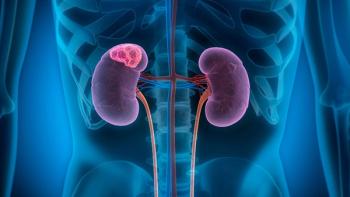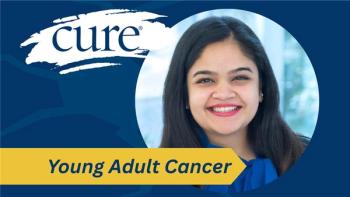
Frontline Treatment Options for Stage 4 RCC
Transcript:
Karl J. D’Silva, M.D.: Steve, when you met me we were deciding what the frontline therapy was going to be for you.
Steven Gallant: Yes.
Karl J. D’Silva, M.D.: There was a lot of option because when I saw you, you came in a wheelchair, and then I wondered, wait a minute, his quality of life is not going to be good. He’s starting out moving in a wheelchair. He’s hardly able to get up and get on to the examination table, and I wanted to know how you were before you got this diagnosis. You had said to me that you were very active, and we were talking about clinical trials. So what was that that changed and how did you accept some of the recommendations?
Steven Gallant: When I first sat down with you, I asked you what the options were, and you told me all the options. But the one that made sense to me is the one that you were really keen on. I could tell just by the uplift in your voice, believe it or not, that you were pretty excited about the cabo [cabozantinib]. And I opted for that because you seemed so positive in the trials that had come forth. So right away I was leaning to that before we even finalized everything. And that’s why I asked you about all the different drugs and I was interested in the immunotherapy, but you kept going back to the clinical trials on the cabozantinib, which is why I knew you were so positive about how it had come through the clinicals.
Karl J. D’Silva, M.D.: Wow.
Steven Gallant: So that’s why I opted for that one.
Karl J. D’Silva, M.D.: When Steve presented to me, he had really aggressive disease. His disease was spreading into the lung as well as the liver, and the retroperitoneal region. So my first concern is, if I’m going to give him immunotherapy, with an extensive disease it’s going to take some time for immunotherapy to work. Immunotherapy is great as long as you don’t have large volume metastatic disease and aggressive disease.
At that point, he presented to me in January, but somewhere late December, cabozantinib got approved. And one of the unique mechanisms of cabozantinib was it targets VEGF [vascular endothelial growth factor], AXL and MET. So we had seen that cabozantinib had a positive clinical trial result to when it was compared to sunitinib, and sunitinib was there for at least 10 long years as the first-line standard of care. But many of the patients developed activating resistance mutation with the AXL and MET, which was going to be targeted by cabozantinib. And I said to him, “I think the way you’re progressing, even after taking the kidney out, I think we need to use something that is going to give us immediate response. So I decided with him as a partnership, that we need to start this pill, and he was on board with it.
Steven Gallant: Yes, I’m the type of person that I’m into a lot of the newer style stuff. It’s really not new at all, it’s been around for tens of thousands of years, but I was always into holistic practices. I never went to the doctor, never had checkups. I was incredibly healthy. I was a 265-pound body builder, weightlifter. I did compete in power lifting when I was younger. And I did yoga, did a lot of ice skating, roller skating, all the sports with my son. And when I went to you I couldn’t even move. It was amazing. I just knew that the newer stuff that was coming out was a more viable and a better option for me. And like I say, I always went to holistic healers. I did massage therapies. I’ve always been in the chiropractor’s office. I still go every six weeks. I have been since the 1970s, and I was always afraid of the hospitals. And here they were, they just saved my life. When you spoke about the new research and everything, that was good.
Karl J. D’Silva, M.D.: Yes, because at that point Steve needed something to give him an immediate response, and cabozantinib had just gotten FDA approval, and it had beaten basically sunitinib, which was there for a long time.
Steven Gallant: That was only like two weeks after the operation I saw you.
Karl J. D’Silva, M.D.: Yes.
Steven Gallant: And then, what happened? Five weeks later I got rushed to the hospital. The cancer went rabid, and it had spread to the outside of my pancreas, back into the liver.
Karl J. D’Silva, M.D.: Yes.
Steven Gallant: To my other kidney.
Karl J. D’Silva, M.D.: Right, I remember that.
Steven Gallant: Again, you know I wasn’t scared. I said, “Please stop the pain,” because the cancer on the pancreas was incredibly painful. It brought me to my knees. It was so painful that I just kept throwing up. It just, I’d never been in so much pain.
Karl J. D’Silva, M.D.: And he was admitted in the hospital, and my colleague, who was taking care of him on the inpatient service called me and he said, “What do you want to do with him?” I said, “He’s got the pill at his place at home. Tell him to start now because I do not know what we can expect. But at least we can start the treatment and see whether he’s going to respond or not.”
Steven Gallant: Yes, he came to me within a couple minutes after that phone call because they came in the next morning and he said, “You have to go home right now and start your medication,” which was surprising to me because I was in so much pain when I got there. So they put me on painkillers and helped relieve that pain. And they sent me home Saturday; I started that day.
Karl J. D’Silva, M.D.: Always there is a question whether patients should be a partner in deciding what the treatment options are and whether they can be involved in their care. And I said, “I want you to be a partner in the decision-making process. And because the data keep changing, you know better data comes by, but I wanted you to be informed. I wanted to be very transparent with you.” I think that was an important part in this decision-making process. What is your thinking about this shared decision making?
Steven Gallant: My father died of cancer, lymphoma cancer, different of course, but I watched the treatment he had and he just kept wilting away, and he just died. It looked like he was dying from day one. And me on the other hand I didn’t want to do that. I just didn’t want to go the old route. I didn’t think it was a good option for me. And I could tell from your positivity, that’s key for me too because I’m very positive. But I could tell just by the way you were talking that it was something that was on the front lines that was an option. I could tell and I knew, and I was excited.
Transcript Edited for Clarity




